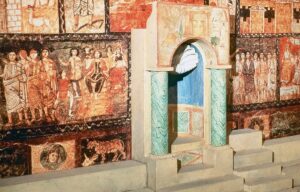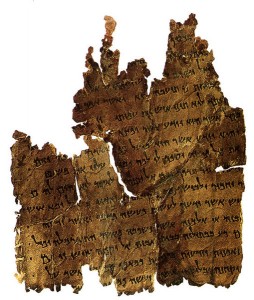Dura-Europos
 In a museum in Damascus, the remnants of a shul from the 3rd century CE linger, telling secrets of our history.
In a museum in Damascus, the remnants of a shul from the 3rd century CE linger, telling secrets of our history.
Sadly, the last vestiges of the ancient Jewish communities of Syria and Iraq, those remnants that had survived the riots that ensued with the creation of the State of Israel in 1948 and its victory over the Arabs in 1967, have come to what is probably a permanent end. Yet these countries still have enormous treasures of Jewish archaeology and history that are in danger of destruction and that, in any case, very few of us will ever see. Can you believe this irony of history? The decorated walls, including the artwork surrounding the aron kodesh on the western wall, facing Yerushalayim, of a third century CE shul building from the ancient city of Dura-Europos, sits in a museum in Damascus.
Baruch A. Levine: A Brief Biography
 Baruch A. Levine was the elder of two sons of Benjamin B. and Helen K. Levine. He was born on July 10, 1930, in Cleveland, Ohio and had a younger brother, Joseph H. Levine.
Baruch A. Levine was the elder of two sons of Benjamin B. and Helen K. Levine. He was born on July 10, 1930, in Cleveland, Ohio and had a younger brother, Joseph H. Levine.
In Cleveland Heights, Baruch Levine attended the public schools and graduated from Heights High School in 1948. In 1951 he earned a B.A. in Comparative Literature with an emphasis on French literature from Adelbert College of Western Reserve University. It was here that he acquired the sensitivity to literary issues that would play so great a role in his analysis of biblical texts.
Read the rest of this biography on De Gruyter.
S. D. Fraade’s The Damascus Document, The Oxford Commentary on the Dead Sea Scrolls
 Remarks from the online book launch, December 16, 2021.
Remarks from the online book launch, December 16, 2021.
Lawrence H. Schiffman
Scholars in a variety of fields should salute the publication of Steven Fraade’s new commentary on the Damascus Document. Indeed, the same could be said about the entire series, but we will be concentrating here on his volume that we are celebrating here today. It is an excellent commentary and represents the first commentary on this text making full use of the entire published corpus of Dead Sea Scrolls. Further, it represents a kind of de facto boundary line, since it no longer refers directly to works written about this text before the discovery of the Scrolls. So we finally have an up-to-date commentary on this document.
I would like to use my opportunity today to take the new volume as a jumping off point and to ask how the Damascus Document fits into the wider questions pertaining to the history of Jewish law. In his discussion of this topic, Fraade correctly points to the difficulties inherent in the use of the term halakhah, a rabbinic designation. He avoids it. In what follows, I will try to follow that pattern, but the truth is that I have found… Continue reading
